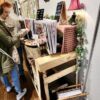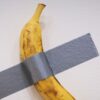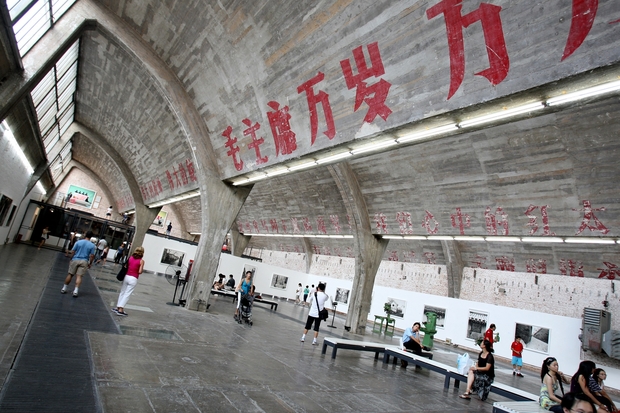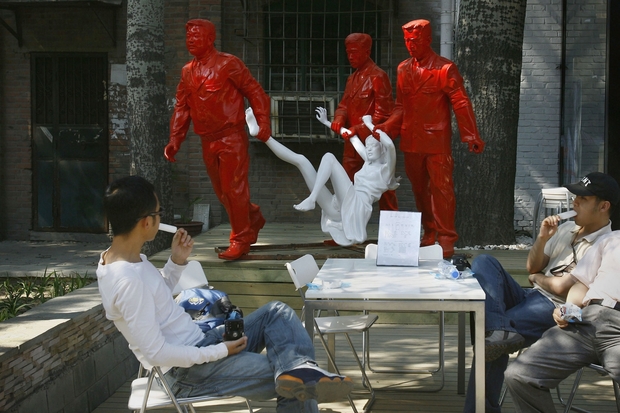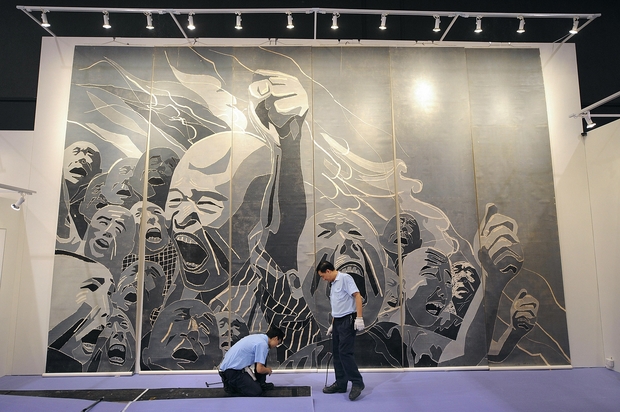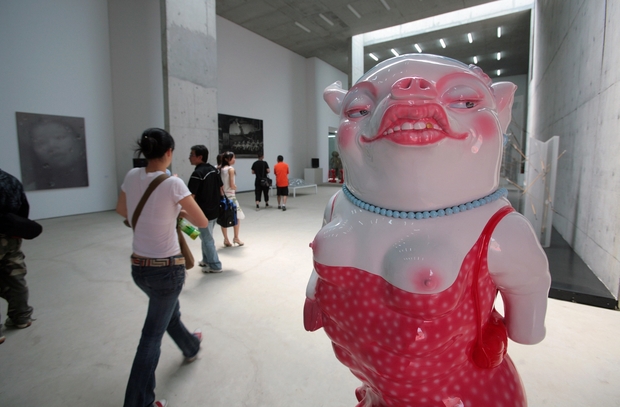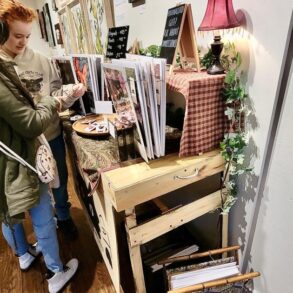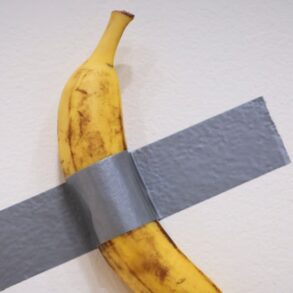The scholar and journalist Kejia Wu is the author of A Modern History of China’s Art Market, a fascinating book that examines the relationship between the Chinese government’s push for cultural “soft power” and its desire for control. In the book, Wu looks at the revival of contemporary art after the Cultural Revolution, as well as the rise of contemporary art and a market for it after the end of the Cultural Revolution; the oddity of China’s parallel art systems: one highly ideological, censored, and state-organized market, and the other market-oriented; and five Chinese artists from different generations whom she profiles.
Jeremy Goldkorn spoke to Kejia Wu in 2023 about her book, and then edited and updated this Q&A with her by email in 2024.
Jeremy Goldkorn: Your book looks at the market for Chinese art going back to the Cultural Revolution. But I first want to talk about the 1990s and the 2000s, when you and I were both in Beijing, and I was tangentially involved in the art scene.
It’s not just that we were there, it was also the period when China’s art market went from basically nonexistent in the ’90s to taking up 30 percent of the global art and antiquities market by 2011, surpassing the U.S. and becoming number one in the world.
How did you land in the middle of the art scene?
Kejia Wu: I went to college in Beijing at Renmin University from ’94 to ’98. My major was real estate management.
Great timing! Just before the real estate industry boomed! But not the usual entry into the art world.
Yes. No.
After graduation, I joined COSCO Real Estate Development Company. And the project I got involved in was on land owned by one of the largest textile factories in Beijing, just near the East Fourth Ring Road. With the government restructuring state-owned enterprises, and the downfall of the textile industry, the factory had to sell the land and move production somewhere else.
And just for context, COSCO is China Ocean Shipping Company, right, and this was the real estate division they launched in the 1990s?
Yes. And I was on the project development team for the takeover of the textile factory site. The factory had been one of the largest state-owned enterprises in Beijing, which contributed a lot of employment to the city. We were thinking, what can we give back to the community?
At the time, there was news about a “loft culture” in New York and London, where large warehouses and industrial spaces with high ceilings and big windows were being converted to contemporary art spaces. I was on a development team working together with a marketing team and we felt like we could do something similar for Beijing. As the residential real estate project was being developed, we decided to keep the textile factory building and turn it into a contemporary art center, and offer free space for painters and dancers to do contemporary projects for free. That was before the 798 project—the idea was still new in Beijing.
There were many artists, including dancers, performing artists, and painters, who were desperate to find a place that was more modern and contemporary for them to exhibit or showcase their performances. And there was nowhere else like that space, a large-scale industrial space with high ceilings.
But since there was nobody at the company who was interested in such an endeavor, the general manager at the real estate company asked me to run it as a contemporary art center. So at the end of the ’90s, and early 2000s, I got the chance to oversee 50,000 square feet of space, and work together with architects and artists and dancers to put together programs for the space. That was the East Modern Art Center (远洋艺术中心).
One of the opening shows was Dancing with Farmworkers, in which I worked together with Song Dong, Yin Xiuzhen, Wen Hui, and Wu Wenguang. They invited migrant construction workers to do an improvised dance performance. The final performance was quite a huge deal in Beijing because of word of mouth. There was not much of an Internet or social media presence back then, but tons of people came.
Yeah, I remember that. What year was it?
The final performance was in August 2001. And there were a few weeks of improvised rehearsals which you may have visited. There was no script. Song Dong and Yin Xiuzhen and Wen Hui and Wu Wenguang just worked and danced with construction workers on a daily basis, purely based on improvised movement.
That’s such an interesting way to get into the art world—via real estate! Such a story of China’s reform and opening era!
Yes.
And at that time, there was no censorship or review process. The whole idea of the dance with the construction workers came up in a brainstorm over the summer. I was sitting on the roof of the Drum Tower [a tower in central Beijing built in 1272] with Song Dong, Yin Xiuzhen, Wen Hui, and Wu Wenguang, just chatting, drinking beer, and eating peanuts. And they’re like, “Why don’t we do something together with construction workers, because they contributed a lot to the urban development of the city but were always the marginalized community and through this collaboration with dancers, they will be put at the center stage.”
Beijing was full of such opportunities.
We didn’t try to plan far in advance. It was all based on this feeling: “Oh, why don’t we do this, this will be exciting.” We just made a decision, we decided to do it then and there. We didn’t have to go through any cultural bureau for a censorship review, or write a memo to get their approval. At that time, you could just think about an idea, you start to do it, and a lot of people come to see the rehearsal. Maybe because of that, the word of mouth got out really quickly, and lots of people came for the final performance.
What did you do next?
There were no alternative spaces like that, so the East Modern Art Center got famous very quickly, and many artists and dancers came to apply for the opportunity to do a show or performance for free.
But then from the management point of view, the brand-building purpose was achieved, and they wanted to focus on growing the business and generate more profit. And I think it was too edgy, too avant-garde, and the concept of having something like 798 that would last for decades, that didn’t really occur to them. They felt that the mission was accomplished within a short period of time and decided to demolish the art center and build residential buildings on the land [in 2003].
So I left. For a time, I ran the communications department for Dow Jones. Then I joined a British firm called Brunswick, which had an art advisory practice. I was advising foreign institutions like the British Museum and the Victoria and Albert Museum on their China programs. Then I got my business degree at Yale, and then I joined Sotheby’s, the auction house in New York City, and subsequently taught at Sotheby’s Institute of Art in NYC and Claremont Graduate University in Los Angeles.
And based on all those experiences and quite a bit of research, I wrote the book. But I think everything that got me interested in this topic can be traced back to the end of the 1990s and early 2000s. Because that experience at that time cannot really be replicated, anywhere in the world.
Such an exciting time. And as you said or hinted, if you operated outside of the official cultural system, or in my own experience the publishing and Internet systems, you didn’t really have any censorship. It was the age of not asking for permission but saying sorry later if you got into trouble.
That started to change quickly, as the government started to figure out that people were doing cultural things beyond their control, but also, as your book documents, that there was money to be made.
So can you explain how art systems developed? Your book describes the evolution of two separate, parallel art systems: the private market system and the state system. What does that look like now?
The state system has a structure where the leadership on content is by the Ministry of Propaganda and the Ministry of Culture and Tourism. They basically will review and make sure the message is right. It must be in line with “Cultural Construction” (社会主义文化建设) and “the Great Rejuvenation of the Chinese Nation,” and everything defined clearly as “Xi Jinping Thought on Culture” [introduced in October 2023]. The whole trend started when Xi became Party General Secretary in 2012.
So pretty much that means under the leadership of Xi Jinping, there is the Party, the Propaganda Department, and the administrative infrastructure, including the Ministry of Culture and Tourism, and the universities, like the Central Academy of Fine Arts [CAFA], and then the Chinese Artists Association. Everyone in these organizations has to abide by guidelines instructed by Xi Jinping to “tell China’s story well.”
How does it function as a market? If you do the officially approved type of art, how do you get paid?
The state has funding to support artists to do those officially-approved creative projects. For example, in 2021, the CCP [Chinese Communist Party] History Museum was officially launched in Beijing. At the time, the government allocated funds to the top academies, including the China Academy of Art in Hangzhou and the Central Academy of Fine Arts in Beijing. They selected “reliable” faculty members and commissioned them to create art works to be displayed in the CCP History Museum as educational tools.
There’s a China National Arts Fund. It’s a grant-making fund which has been funding a variety of projects. If you look at the list of the projects [such as those] discussed in my book, you see they are pretty much restricted to works which promote traditional Chinese culture, or that tell attractive, good China stories, or endorse “the Great Rejuvenation of the Chinese Nation.” Artists who need to get paid and want to advance their career in the state system are willing to compete for those opportunities.
What about the market system that used to be almost completely separate? How did the private art market develop and what does it look like now?
In the late 1990s to mid-2000s, artists like Zhang Xiaogang, whom you mentioned before we started recording, that kind of artist became popular with foreign collectors. At that time, the Chinese contemporary market was starting to do very well, driven by new demand from international collectors, people like Guy Ullens and Uli Sigg. Very soon, Chinese artists like Zhang Xiaogang were represented by blue chip Western galleries like Pace.
Artists like that are often not part of the official state system. They make their living by having shows through their galleries, and galleries often bring the artists’ work to art fairs. The galleries help generate sales for them. Artists can survive outside of the state system by being represented by commercial galleries.
However, now the authorities review all their exhibitions (unless the Chinese artist creates their work outside of the country and it is exhibited overseas), including gallery shows, domestic public and private museum shows, and any artworks sent abroad. If these artists have shows in New York, all their paintings will have to be reviewed. And the review process can take three months, but it’s very hard to predict, it can take longer.
How strict is it now? When I was writing about art in the late 1990s, I remember the Post-Sense Sensibility exhibition that had works with human body parts. Crazy stuff with dead babies and animals. And there were plenty of artists who totally lacked the “positive energy” the government asks of its artists today: Fang Lijun, Zeng Fanzhi, Zhu Wei, and everyone in the Life exhibition.
I can’t imagine anything like that would pass muster today. How much stricter has it got?
There are no clear official guidelines of art exhibitions that say, oh, you can’t show this or that. But you can discern some basic rules over the years from seeing what was actually regulated.
When you and I were in Beijing art circles in the late ’90s, the criteria were quite simple. Nothing pornographic, nothing clearly anti-socialism, but everything else was pretty much okay.
But it’s been getting stricter and stricter, especially in recent years. In 2016, the Ministry of Culture issued a regulation with 11 clauses [about] visual artworks forbidden from exhibiting/exporting. Let me quote them, from chapter six of my book:
- Opposing the basic principles established by the Constitution
- Endangering national unity, sovereignty, and territorial integrity
- Leaking state secrets, endangering national security, or harming national honor and interests
- Inciting ethnic hatred, ethnic discrimination, undermining national unity, or harming ethnic customs and habits
- Undermining national religious policies, promoting cults and superstition
- Promoting terrorist activities, spreading rumors, disturbing social order, undermining social stability
- Promoting obscenity, pornography, gambling, violence, or abetting crime
- Insulting or slandering others, infringing on the legitimate rights and interests of others
- Contrary to social morality or national cultural traditions
- Deliberately falsifying history, serious distortions of history
- Any other content that is prohibited by laws, regulations, and state regulations
Look at this list, it’s very ambiguous. For example, nudity in the past was tolerated, but now is a taboo subject. Anything related to nudity will be taken out, although it is still at the discretion of the local Culture Bureau officials and in very rare cases may still be shown.
For example, Taikang [Space] art museum, which is owned by Chen Dongsheng who founded China Guardian Auctions. They just opened their private museum in Beijing last year. There was at least six months of review process for the opening show. First they had put what they intended to include in the exhibition on a list, and sent it to the Cultural Bureau for at least three rounds of reviews. After that, they put the approved paintings on the wall, and then officials from the local Cultural Bureau will show up in person for the last time before the show can open to the public.
What happened to Chen Dongsheng’s Taikang Art Museum? [He is supposed to be] a “safer” entrepreneur because his wife is the granddaughter of Chairman Mao, right? You would think that after all the paperwork, this private museum should be okay. But what I heard was, on the VIP preview day before the exhibition opened to the public, the cultural bureau officials showed up in person. And they were pointing at a number of paintings, including a Zeng Fanzhi painting, which, despite the fact it had the paperwork review, had to be taken down because of nudity, and a Zhang Xiaogang painting had to be taken down because the government officials felt the ambiance of the painting was negative, it didn’t tell a good China story. There is just so much ambiguity, the decision was completely up to the government officials who were standing in the gallery space, making the decision right there.
All of Zhang Xiaogang’s paintings are negative! That’s kind of the whole point, that you don’t know what’s going on in the paintings, and it’s never 100 percent good, right?
For example, he had his show last year in spring at the Long Museum in Shanghai, which was a recap of his experience during the pandemic because he was in lockdown, including being put into a fangcang hospital [temporary hospitals designed to be set up quickly in existing spaces to isolate COVID-19 patients] multiple times. During the pandemic, he was in pretty tough lockdowns for a total of more than 40 days. He wrote a quarantine diary and described those experiences in his paintings.
Six months after the show, his catalogue was still being reviewed. He said words like “pandemic” and “quarantine” and “death”; all these words had to be removed from the catalogue. The catalogue went through multiple publishers—some of them decided to give up because the review process was so long. The catalogue finally came out at the end of 2023 but none of the catalogue essays included words like “pandemic,” “quarantine,” and “death.”
It sounds like there’s not going to be a meaningful difference between the private and state systems, with this level of scrutiny and censorship?
There are a number of examples that can help us to see where things are going. There are certain artists, for example, Qiu Zhijie: he was quite edgy, avant-garde. He did calligraphy on his body and those early works were included in numerous international museum collections. But now he’s the President of Tianjin Academy of Fine Arts, one of the state-run art academies in China. He’s an example of an experimental contemporary artist who sees the benefit of being in the state system, and he would like to advance his career within the system. Maybe from his perspective, he has a desire to elevate his social impact. And being in China with funding from the government, he can do a lot of things, which might be hard to do overseas, even though he’s very famous among international museum curators.
There are artists who are like Liu Xiaodong, whose paintings have become much less critical. He even went to the National People’s Congress [NPC] as a representative. And then he would share his experiences at the NPC in lectures at CAFA. The state system has grown so powerful, if you become a director or deputy director at a university or at CAFA, you have so many international exchange opportunities, and government funding. For ambitious artists, that could be very attractive.
CAFA recently chose a new president, Lin Mao, born in the mid-70s, one of the youngest ever appointed. Initially, a group of old professors at CAFA jointly wrote a collective open letter to the Ministry of Education to say “please reconsider, we need somebody who has better credentials because CAFA has a long history of choosing well-established, renowned artists as its president, including Xu Beihong, Wu Zuoren, etc.” The Ministry of Education wrote back to those professors who complained and said Lin Mao is very loyal to the CCP, we believe he’s committed and he’s a good choice. And I heard those professors who wrote the letter were investigated. So very soon, everyone became pretty obedient to this decision. The dean of CAFA’s architecture school, who was one of the professors who wrote and signed the letter of complaint, joined the new President Lin Mao to meet the celebrity architect Rem Koolhaas—he went to Beijing to meet with the faculty and talk about collaboration. That kind of social status is really attractive for a lot of people. [Koolhaas’ firm designed the iconic CCTV building.]
On the other hand, artists who don’t want to be part of the system will stick to collaboration with their galleries or independent art institutions (including international museums). And hopefully, those galleries, particularly Western galleries, can help them generate more sales overseas or create exhibition opportunities outside of China. So the two trajectories are happening at the same time.
What about the Chinese world outside of the People’s Republic of China? People like Ai Weiwei. He is unusual in that he has made a global career, he’s part of a global art market that doesn’t really have anything to do with China anymore. Are we going to see more exiled Chinese artists like Ai Weiwei?
In the next five to 10 years, definitely more artists will establish studios overseas, some people might decide to immigrate to another country, depending on their family situations.
The censorship is getting so much worse. For example, there is an artist whose work is based on Buddhist philosophy, and often incorporates elements of human limbs and bodies—nudity. Before 2019, she often had artworks shown domestically, but now her figurative artworks that reference nudity would not pass the censorship review domestically. She has a studio in Austria, and is trying to create a studio in Berlin. [She is not named to protect her identity as she is still working in China.]
And then there is one artist I described in my book who has already established a studio in Tokyo, Lu Yang. Although he has a studio in Shanghai, he pretty much creates all his artworks in Tokyo now. Because he’s a Buddhist, and almost all of his artworks are related to Buddhism, he likes to explore subject matter such as the concept of hell, death, and bardo. That’s not a positive kind of story from the official arts and culture rhetoric perspective. When I was writing the book, around the time when the pandemic broke out, he still had videos being exhibited in China, but now, many of his videos cannot be shown in China.
Everything got worse after the pandemic, I guess.

